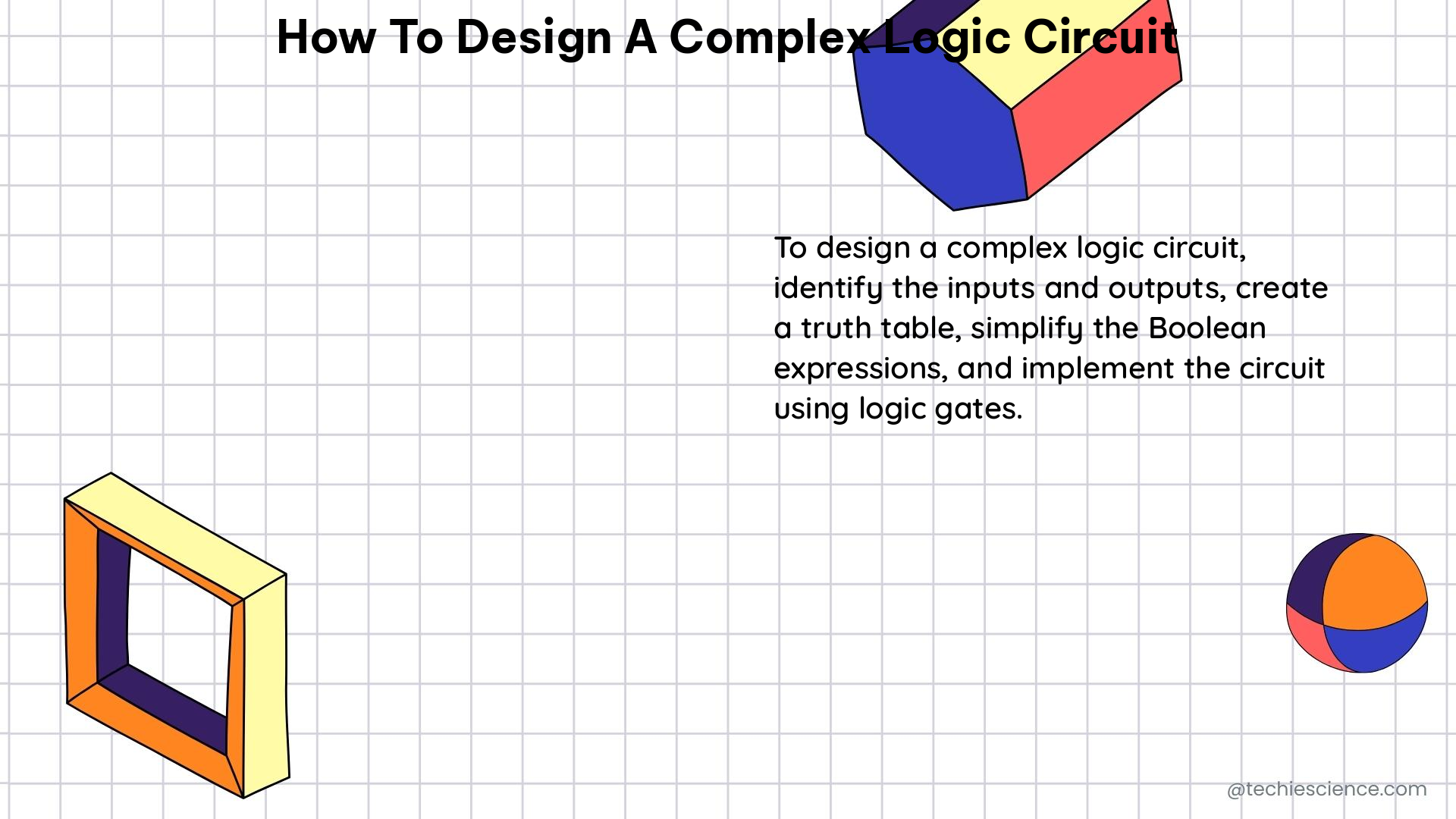Designing a complex logic circuit involves a systematic approach that encompasses understanding the problem, creating a truth table, simplifying the Boolean expression, and implementing the circuit using logic gates. This comprehensive guide will walk you through the step-by-step process, providing you with the necessary tools and techniques to tackle even the most intricate digital circuit design challenges.
Understanding the Problem
The first step in designing a complex logic circuit is to clearly define the problem you want to solve. This involves identifying the input and output variables, as well as any constraints or requirements that the circuit must meet. By thoroughly understanding the problem, you can ensure that your design will effectively address the desired functionality.
Creating a Truth Table

Once you have a clear understanding of the problem, the next step is to create a truth table. A truth table is a tabular representation of all possible combinations of input variables and their corresponding output values. This step is crucial as it lays the foundation for the subsequent simplification of the Boolean expression.
Simplifying the Boolean Expression
After creating the truth table, the next step is to simplify the Boolean expression using Boolean algebra and Karnaugh maps. Boolean algebra provides a set of rules and theorems that can be used to manipulate and simplify logical expressions, while Karnaugh maps offer a graphical method to minimize Boolean expressions by grouping adjacent 1’s or 0’s in a two-dimensional grid.
Implementing the Circuit Using Logic Gates
With the simplified Boolean expression in hand, you can now design the logic circuit using basic logic gates such as AND, OR, NOT, NAND, NOR, XOR, and XNOR. Each gate represents a specific logical operation, and by combining these gates, you can create complex digital circuits that perform the desired functionality.
Optimizing the Circuit
To further enhance the performance and efficiency of the complex logic circuit, you can employ various optimization techniques. These include two-level logic optimization, multi-level logic optimization, and sequential logic optimization. These techniques aim to reduce the number of gates and improve the overall circuit performance, making it more suitable for real-world applications.
Theorems, Formulas, and Examples
To design a complex logic circuit, it’s essential to have a solid understanding of the underlying principles and mathematical concepts. Here are some key theorems, formulas, and examples that you should be familiar with:
De Morgan’s Theorem
De Morgan’s theorem states that the negation of a logical conjunction is equal to the logical disjunction of the negations of its terms, and vice versa. It can be expressed as:
Boolean Algebra Formulas
The following Boolean algebra formulas are essential for simplifying and manipulating logical expressions:
Example
Let’s consider a complex logic circuit that implements the Boolean function:
F(A,B,C,D) = !A * B + !B * C * D
The truth table for this function is:
| A | B | C | D | F |
|---|---|---|---|---|
| 0 | 0 | 0 | 0 | 0 |
| 0 | 0 | 0 | 1 | 0 |
| 0 | 0 | 1 | 0 | 0 |
| 0 | 0 | 1 | 1 | 0 |
| 0 | 1 | 0 | 0 | 0 |
| 0 | 1 | 0 | 1 | 1 |
| 0 | 1 | 1 | 0 | 0 |
| 0 | 1 | 1 | 1 | 1 |
| 1 | 0 | 0 | 0 | 0 |
| 1 | 0 | 0 | 1 | 0 |
| 1 | 0 | 1 | 0 | 0 |
| 1 | 0 | 1 | 1 | 0 |
| 1 | 1 | 0 | 0 | 1 |
| 1 | 1 | 0 | 1 | 1 |
| 1 | 1 | 1 | 0 | 0 |
| 1 | 1 | 1 | 1 | 1 |
Using Boolean algebra and Karnaugh maps, the simplified Boolean expression for F(A,B,C,D) is:
F(A,B,C,D) = B * !C * D + !A * B
The logic circuit for this function can be implemented using basic logic gates as shown in the following diagram:

By following the steps outlined in this guide and leveraging the provided theorems, formulas, and examples, you can effectively design complex logic circuits that meet your specific requirements.
References
- Power and Delay Analysis of Logic Circuits Using Reversible Gates
- Logic optimization – Wikipedia
- How To Design And Implement Digital Circuits Using Logic Gates and Boolean Algebra
- Is there any idea to reduce the complexity of the logic circuit? – Reddit
- Combinational Logic – an overview | ScienceDirect Topics

The lambdageeks.com Core SME Team is a group of experienced subject matter experts from diverse scientific and technical fields including Physics, Chemistry, Technology,Electronics & Electrical Engineering, Automotive, Mechanical Engineering. Our team collaborates to create high-quality, well-researched articles on a wide range of science and technology topics for the lambdageeks.com website.
All Our Senior SME are having more than 7 Years of experience in the respective fields . They are either Working Industry Professionals or assocaited With different Universities. Refer Our Authors Page to get to know About our Core SMEs.